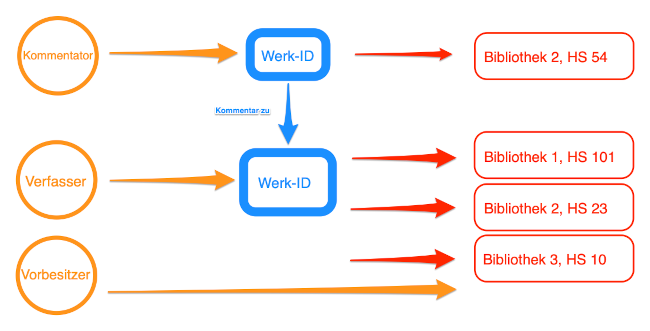Qalamos – Connecting Manuscript Traditions
Qalamos ist das Portal für Handschriften und Blockdrucke aus asiatischen und afrikanischen Schrifttraditionen. Es werden ca. 175.000 Datensätze verschiedener Entitäten zu mehr als 120.000 physischen Objekten in unterschiedlicher Erschließungstiefe vorgehalten – Schriftzeugnisse in insgesamt 170 Sprachen und 87 Schriften (Stand März 2024). Perspektivisch ist ein möglichst vollständiger Nachweis der in deutschen Gedächtnisinstitutionen bewahrten Bestände und ihrer Digitalisate angestrebt. Darüber hinaus werden auch Bestände internationaler Kooperationspartner im Portal präsentiert.
Qalamos wird derzeit im Rahmen des DFG-Projekts Qalamos (2023−2026) weiterentwickelt. Ausführliche Informationen zum Projekt finden Sie auf der Website der Staatsbibliothek zu Berlin.
Qalamos ist eine MyCoRe-Anwendung des Rechenzentrums der Universität Leipzig. Die Gesamtverantwortung liegt bei der Orientabteilung der Staatsbibliothek zu Berlin – Stiftung Preußischer Kulturbesitz.
Die drei zentralen Module der Datenbank sind Handschriften, Personen und Werke. Die Handschriftendatensätze enthalten Angaben zu Titel, Verfasser und Inhalt eines Textes, sowie zur Materialität des Objektes. Darüber hinaus geben sie Auskunft über die Provenienz der Handschrift. Das Personen-Modul enthält normierte Daten von Verfassern, Kopisten, Vorbesitzern und anderen an einer Handschrift beteiligten Personen. Über die im Werk-Modul angelegten Titeldatensätze findet man in Qalamos nachgewiesene Exemplare eines jeweiligen Werkes sowie Verknüpfungen zu Kommentaren, Übersetzungen und anderen Expressionen.
Kontakt: qalamos@sbb.spk-berlin.de
Das DFG-Projekt "Orient-Digital" (2020–2023)
Qalamos wurde im Rahmen des DFG-Projekts "Orient-Digital" entwickelt. Projektpartner waren die Bayerische Staatsbibliothek München, die Forschungsbibliothek Gotha, die Staatsbibliothek zu Berlin und das Universitätsrechenzentrum Leipzig. Daneben kooperierte das Projekt mit mehr als 20 weiteren Institutionen.
Ziel des Projektes war die Zusammenführung der Informationen zu verstreut nachgewiesenen orientalischen Handschriften in Deutschland und der Aufbau einer homogenen Nachweisstruktur. Dies erfolgte durch die Retrokonversion gedruckter älterer Kataloge und die Datenübernahmen aus bestehenden Anwendungen. In der ersten Projektphase standen die Sprachgruppen Arabisch, Persisch und Osmanisch-Türkisch im Mittelpunkt der Bearbeitung.
Ein wesentliches Projektziel stellte die Standardisierung der erfassten Daten gemäß bibliothekarischer Standards dar. Hierzu gehörte die Sichtung, Verbesserung und Generierung von Normdaten innerhalb der Anwendung wie auch in der Gemeinsamen Normdatei (GND) der Deutschen Nationalbibliothek (DNB). Ausführliche Informationen zum Projekt finden Sie auf der Website der Staatsbibliothek zu Berlin.
Wissenschaftlicher Beirat
- Dr. Volker Adam (FID Nahost, ULB der Martin-Luther-Universität Halle-Wittenberg)
- Dr. habil. Dragomir Dimitrov (Philipps-Universität Marburg, Institut für Indologie und Tibetologie)
- Prof. Dr. Christoph Emmrich (University of Toronto, Department for the Study of Religion)
- Yasmin Faghihi (University of Cambridge, University Library)
- Prof. Dr. Nathan Gibson (Ludwig-Maximilians-Universität, Institut für den Nahen und Mittleren Osten)
- Dr. Till Grallert (Humboldt-Universität zu Berlin)
- Prof. Dr. Konrad Hirschler (Universität Hamburg, Asien-Afrika-Institut)
- Prof. Dr. Verena Klemm (Universität Leipzig, Orientalisches Institut; SAW Leipzig (Bibliotheca Arabica)
- Dr. Philipp André Maas (Universität Leipzig, Institut für Indologie und Zentralasien-wissenschaften)
- Dr. Jonas Müller-Laackmann (Staats- und Universitätsbibliothek Hamburg Carl von Ossietzky)
- Dr. Kathrin Paasch (Forschungsbibliothek Gotha)
- Birgit Seiderer (Bayerische Staatsbibliothek München)
- Prof. Dr. Tilman Seidensticker (Universität Hamburg, Centre for the Study of Manuscript Cultures)
- Prof. Dr. Sabine Schmidtke (Institute for Advanced Studies, Princeton University)
- Dr. Carolin Schreiber (Stabi Berlin, Abteilung für Handschriften und Historische Drucke)
- Prof. Dr. Ronny Vollandt (Ludwig-Maximilians-Universität München, Institut für den Nahen und Mittleren Osten)
Projekt-Team
Staatsbibliothek zu Berlin
- Gesamt-Projektleitung: Christoph Rauch
- Karin Druxes
- Dr. Yoones Dehghani Farsani
- Dr. Thoralf Hanstein
- Dr. Michaela Hoffmann-Ruf
- Dr. Anett Krause
- Larissa Schmid
- Beate Wiesmüller
Bayerische Staatsbibliothek München
- Ralf Kramer
- Wolfgang Schmitt-Garibian
- Dr. Gleb Sharygin
- Dr. Thomas Tabery
- Dr. Felix Wiedemann
Universitätsrechenzentrum Leipzig
- Dr. Michael Becker
- Moritz Engelmann
- Andreas Kluge
- Jens Kupferschmidt
Ehemalige
Wael Abbas (FB Gotha), Maysa Albert (BSB München), Dr. Ghazwan Kanbar (SBB Berlin), Dr. Feras Krimsti (FB Gotha), Colinda Lindermann (SBB Berlin), PD Dr. Monika Müller (FB Gotha), Julia Singer (BSB München), Dr. Torsten Wollina (SBB Berlin), Mirja Wachter (BSB München)
Kontakt: qalamos@sbb.spk-berlin.de
Zum Namen des Portals Qalamos
Das altgriechische Wort kalamos (κάλαμος) bedeutet Schreibrohr. Im Arabischen und Persischen wurde daraus, vielleicht über das äthiopische qalam (ቀለም), das Lehnwort qalam (قلم), das bereits im Koran vorkommt. Im Swahili wurde qalam zu kalamu. Das griechische kalamos wurde als calamus ins Lateinische und als kulmus (קולמוס) ins Hebräische übernommen; dort kann es auch die Schreibfeder bezeichnen. Auch Sanskrit kalama (कलम) ist davon abgeleitet.
Der Name des Portals vereint diese Schreibweisen zu einem Kunstwort. Das Logo symbolisiert die Bedeutung: der Querstrich des Q stellt das Schreibrohr dar, das soeben in Rot die diakritischen Punkte des arabischen Buchstaben Qāf (ق) von qalam geschrieben hat. Die rote Tinte dient in vielen Handschriftentraditionen zur Auszeichnung bestimmter Textteile (Rubrizierung, von Latein ruber, rot), wie Überschriften oder Zitate.
Mit dem Namen und dem Logo wollen wir auf die Verbindung der Handschriftentraditionen hinweisen – eine historische Verbindung, die durch die Zugänglichkeit dieser Handschriften im Portal wieder besser sichtbar und nutzbar wird.



